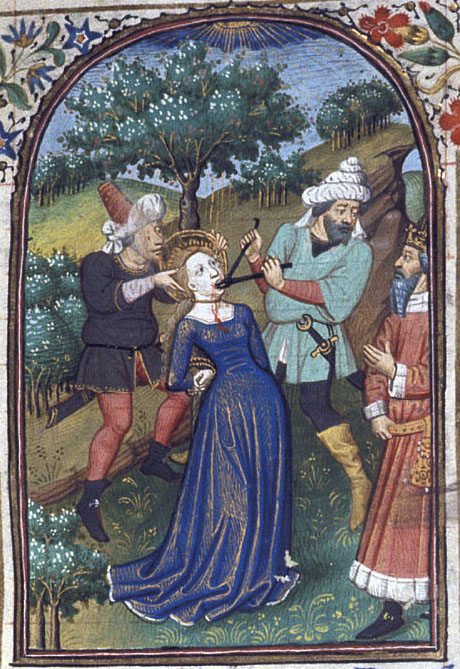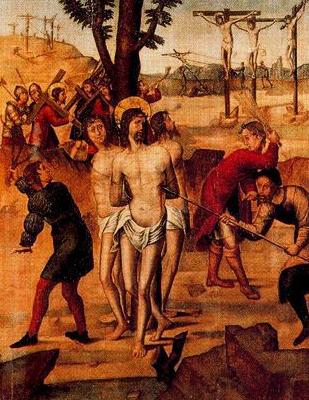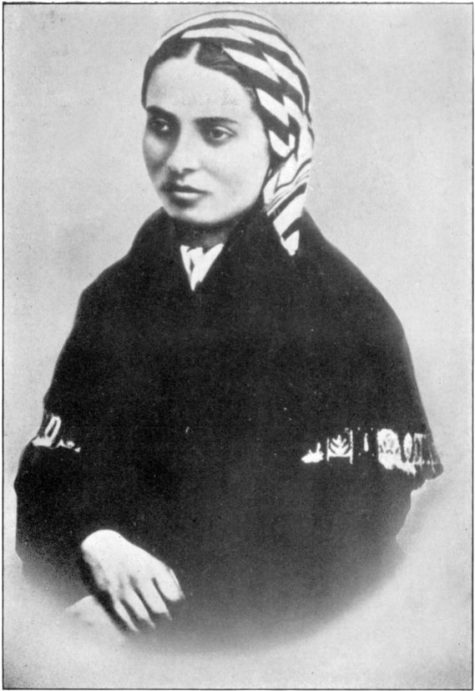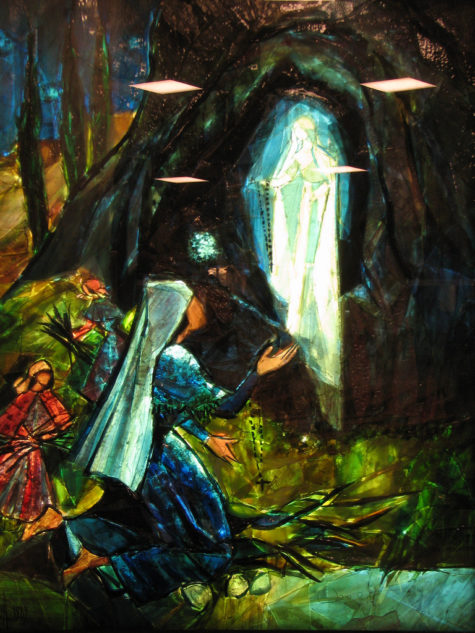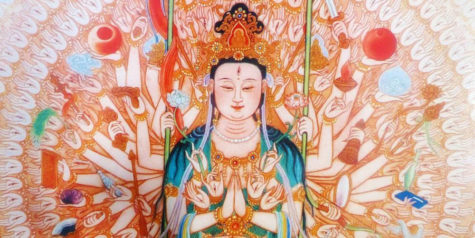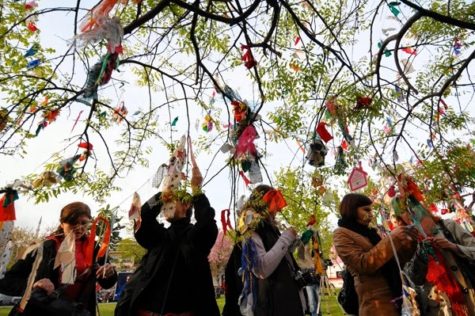Healing
February 9th is the feast day of Saint Apollonia, patroness of dentistry and those suffering from toothache or other dental problems. It is believed that whoever says a prayer to Saint Apollonia should have no pain in his teeth on the day of the prayer.
Her story is as follows:
In a persecution of the Christians, stirred up by ” a certain poet of Alexandria,” she was seized, and all her teeth were beaten out, with threats that she should be cast into the fire ” if she did not utter certain impious words,” whereupon, of her own accord, she leaped into the flames.
This is the prayer:
” O Saint Apollonia, by thy passion, obtain for us the remission of all the sins, which, with teeth and mouth, we have committed through gluttony and speech; that we may be delivered from pain and gnashing of teeth here and hereafter; and loving cleanness of heart, by the grace of our lips we may have the king of angels our friend. Amen.”
— W. G. Willis Watsox.
The feast day of St Agathius is May the 7th, (formerly May 8th). It is unclear why the date was changed, and some information online still has it listed as May the 8th. He is a patron saint of soldiers, and most often invoked against headaches.
- About him:
Saint Agathius (Greek: Ακακιος; died 303), also known as Achatius or Agathonas or Acacius of Byzantium, according to Christian tradition, was a Cappadocian Greek centurion of the imperial army, martyred around 304.
Agathius was arrested on charges for being a Christian by Tribune Firmus in Perinthus, Thrace, tortured and then brought to Byzantium where he was scourged and beheaded, being made a martyr because he would not renounce his Christian faith. The date of his martyrdom is traditionally May 8, when his feast is observed.
- Note:
St. Acacius the Centurion is not to be confused with the St. Acacius who was crucified in the second century along with 10,000 (!) companions. Neither of these martyrs is the St. Achatius numbered among the “14 Holy Helpers.”
- For Headaches:
I’ve found that amethyst is one of the best gemstones to help relieve headaches and reduce stress and tension. You can simply sit quietly and hold a piece of amethyst against your forehead, or you could make a gem elixir so that you can take a drop or two of the liquid when necessary.
Another traditional spell is to find a pebble and hold it against your head and say: ‘Pain from my head go into this stone, go into this stone, go into this stone. Pain from my head go into this stone, go into this stone and stay there.’ Then take the stone outside and hurl it away from you with as much force as you can manage.
Sources:
April 16 is the feast day of Saint Bernadette, although in France it is sometimes celebrated on February 18. Saint Bernadette is best known for her visions of the Virgin Mary in 1858 in Lourdes, France and for the healings that have taken place at the location of the visions. St. Bernadette is the patron saint of:
- Physical illness
- Lourdes, France
- Shepherds and shepherdesses
- Poverty
- Those insulted for their faith
- Family
The young shepherdess who saw Our Lady in Lourdes, St. Bernadette, found solace in her suffering by turning her eyes to Our Lord. Suffering today? Pray this prayer from St. Bernadette
“O Jesus, Jesus,” she prayed, “I no longer feel my cross when I think of yours.”
If you’re suffering today, pray this excerpt of one of her prayers:
Let the crucifix be not only in my eyes and on my breast, but in my heart.
O Jesus! Release all my affections and draw them upwards.
Let my crucified heart sink forever into Thine and bury itself in the mysterious wound made by the entry of the lance.”
Saint Bernadette and The Goddess
If you think the visions of Saint Bernadette have no connection to magick and the Goddess think again – here is an alternative version to the traditional story:
On the cold morning of February 11, 1858, there was no wood in the Soubirous home, and no fire to warm them. Bernadette set out with her younger sister Toinette, and a neighbor girl, Jean Abadie, to scrounge in the forest for kindling. Maybe they would get lucky and find a rag or a bone to sell.
Heading out of town, the girls neared the foot of Massabieille, a massive, cliff-top rock formation, within view of the ancient hilltop fortress that served as the traditional landmark of the town. To reach the woods, they had to ford the river Gave at the bottom of the cliff. Bernadette’s mother had warned her not to get her feet wet, for that would surely bring on the asthma, so while the other two girls scampered across the river, Bernadette reluctantly hung back.
According to her own accounts, as she lingered near the banks of the Gave, the girls calling after her as they hurried into the woods, she heard a sound like rushing wind. The sound seemed to be coming from a dark grotto in the rock wall under Massabielle. The noon Angelus bells were ringing from the town. As Bernadette turned to investigate the source of the wind, she saw what looked like a glowing young girl, tiny, white, and smiling brightly. She appeared to be standing above the eglantine, or wild rose, that draped the niche over the entrance to the grotto.
Bernadette rubbed her eyes and looked again. This time, the tiny demoiselle nodded, as if to greet her, and opened her arms, smiling all the while. Bernadette’s initial reaction was fear, but she couldn’t run away. She said she felt like she couldn’t move, but she did manage to instinctively put her hand in her pocket and draw out her rosary for protection. She tried to make the sign of the cross, but found that she couldn’t.
In response, the shining little maiden also produced a rosary, and crossed herself in a gesture of surprising beauty and grace. This time, Bernadette found she could respond, and after crossing herself, she began to feel calmer and a little less overwhelmed. Dropping to her knees, Bernadette began to pray her rosary. The little lady fingered her beads along with her. When they had finished, the tiny thing beckoned her to come closer, but Bernadette was too overawed to move. She then vanished, all smiles and delicate grace, leaving Bernadette to rejoin her companions.
Bernadette’s descriptions of the tiny, white maiden were consistent throughout the course of her visions. The apparition, whom she called aquero, or “that thing” in the local dialect, appeared youthful and girlish. There was nothing particularly matronly or maternal about her. Bernadette repeatedly said that aquero was about the same size as herself, if not a bit smaller. Bernadette was very small for her age. Although she had recently turned fourteen, the combined ravages of illness and malnutrition kept her about the size of an average 10- or 11-year-old. According to Bernadette’s earliest descriptions, aquero looked to be about 12 years old. This is an important distinction, and one that the well-meaning supporters of Lourdes apparently prefer to ignore.
Aquero, according to Bernadette’s initial descriptions, was a jeune fille; a bien mignonette, glowing in a white dress spun of a luxurious, soft, shiny stuff. Her head was covered in a white veil of the same magic fabric, so that only a tiny bit of her hair was revealed in the front. Her eyes were bright blue, and set in a long and very white face. The whole figure shone with a gleaming, white radiance. Around her waist was a blue girdle, which folded in the front and fell almost to the hem of her robe. Her tiny feet, barely visible beneath her robe, were bare, but each was adorned with a single, golden rose. Her rosary gleamed as well, with shining white beads and links of gold.
This costume is quite significant, for in this particular area of the Pyrenees, the locals maintained a tradition of fairy lore that told of the petito damizela in white who still lingered in the forests and grottoes of the region. When Bernadette first called the apparition a petito damizela, which translates as a petite, unmarried young lady, she may have actually been referring to aquero as a Pyrenean fairy woman. These Pyrenean fairies were tiny, enchanting ladies in glowing, white robes. Charming, helpful, and better natured than most fairy folk, they were recognized by their gleaming garments and said to spend much time washing them to snowy whiteness in the fountains outside their grotto homes.
The roses on aquero’s feet were yet another aspect of local fairy lore, as was Bernadette’s reluctance to call her by any name other than “that thing.” According to the tradition, these delightful fairy women sometimes married mortal men, making good wives and housekeepers – for a time. Eventually, the husband would slip up and call his fairy wife by her name, at which point she would disappear back into the fairy world forever.
In the Basque population of the Pyrenees, we have a unique link into the mindset of our most distant ancestors. There is reason to believe the Basques have occupied the Pyrenees region from the remotest antiquity, possibly even to the time of the Cro-Magnon cave painters. The inaccessibility of their mountain fastness kept them relatively isolated from the Indo-European influences that swept the rest of the continent. Consequently, the Basques have retained a unique language and a culture that, while not entirely untainted by foreign contact, still reveals roots reaching down into our most shadowy origins.
Furthermore, the Basques, with their extensive folklore and mythology, are relative latecomers to Roman Catholicism. Religious writers of the 1400 and 1500s continue to speak of the Basques as “gentiles” or “pagans.” The widespread persistence of their ancient beliefs and practices provoked the full wrath of the Spanish Inquisition. The brutal repression of centuries of witch hunts has left its mark, and clearly, some of the tradition that remains is highly adulterated and Christianized, but we can still trace influences extending far back into the Neolithic, and perhaps beyond.
Basque beliefs are rooted in the landscape, in the rugged mountains, the waters, and the caves reaching deep into the earth. They held to that most primitive fundamentalism, the belief in the divinity of the masculine Sun and the feminine Moon. The terms Ost or Eguzki refer to the light of the sun and their god of the firmament. This masculine force, similar to Zeus or Thor, ruled the day and the world of light, but the night belonged to Ilargia, the Moon. Ilargia ruled the hidden, dark side of nature, the underworld of the dead. The Basques were forever fascinated with her mysterious phases and cycles.
However, the Basque people’s deepest and most widespread devotion, long before the arrival of Christianity in the Pyrenees, centered on their female deity, the great goddess who lived in the caves. Her name, perhaps the ultimate irony, was Mari. Devotion to Mari spanned the entire Basque territory, and any respectable hilltop boasted a shrine to Mari, and a statue as well, but the caves remained her favorite habitation.
Within the vast lore and ritual dedicated to her worship, the image of Mari emerges, complex and glorious. She moved like a fireball from mountaintop to mountaintop, trailing wild storms from the subterranean caverns in her wake. She demanded honor and charity from men, punishing those who failed to keep their word or refused to help others. Oddly enough, tradition holds that Mari must only be addressed in the familiar pronoun, putting a unique twist on Bernadette’s surprise at being addressed formally by her aquero. Mari commanded legions of fairy spirits, with varying titles in different locales: the Mairi, or Maide of the mountaintop cromlechs and stone circles, and the fey laminak, often spotted combing their hair in the caverns.
This great and very ancient goddess spawned a vast body of tales and traditions, and the rituals of her devotees in the caves of the Pyrenees kept the Spanish Inquisition busy for years. One of her most vicious persecutors was Juan de Zumarraga, who, in 1528, assisted in the biggest Basque witchhunt. Zumarraga eventually moved on to Mexico, where, as bishop, he persecuted and destroyed the native Aztec culture and religion just as vigorously as he had brutalized his Basque brethren.
One of Mari’s more popular minions is a creature known as Beigorri, a red-haired bull or calf. One of several cattle deities associated with her worship, Beigorri’s chief function is to serve as the guardian of the houses, or shrines, of Mari. Seen in that light, the tales of a magical bovine unearthing a long-lost statue of a female divinity, which then refuses to be worshiped in a Christian sanctuary but instead draws her devotees back to congregate at her wilderness origins, starts to make a certain kind of sense. Perhaps, in these unique Marian traditions, which continue to spring up so freely, even after centuries of repression, we can trace both the reemergence of the Basque Mari, and her conflation, in the aftermath of the Inquisition, into the all-encompassing image of the Christian Mary.
Sources:
Quan Yin’s Birthday is commonly celebrated on the 19th day of the 2nd lunar month. In 2018 this falls on April 4, but in 2021 it lands on March 26, so you can see the dates vary widely from year to year. The birthday of the Goddess of Mercy is a celebration of the Bodhisattva (“Buddha-to-be”) of infinite compassion and mercy.
Alternate spellings include:
- Kwan Yin
- Kuanyin
- Kuan Yin
- Guanyin
One of the deities most frequently seen on altars in China’s temples is Quan Yin. Quan Yin, the Buddhist Heart of Mercy and Queen of Compassion, is no forgotten deity but among the most popular on Earth today. The most beloved of Buddhist deities, he or she is accepted not only by Buddhists but also by Japanese, Chinese, and Koreans.
On her birthday, young men and women come together and burn joss sticks and worship the goddess either in temple halls or court areas. Some devotees also offer oil for the lamp of Guan Yin. This is an offering meant for peace and health.
Common dishes served on this day include porridge, fried koey teow and noodles, which stays true to authentic Chinese cuisine. All dishes served at the festivities are typically vegetarian as well.
Quan Yin is the Bodhisattva of Compassion. In Sanskrit, her name is Padma-pâni, or “Born of the Lotus.” Quan Yin, alone among Buddhist gods, is loved rather than feared, and is the model of Chinese beauty.
She is a tireless, ever-vigilant protective guardian. Although her appearance is milder than that of a warrior spirit, she is no less powerful. Kwan Yin achieved nirvana but refused to leave Earth as long as any person still suffers. Kwan Yin vows that if you call her name in times of anguish, she will come and assist you.
There are three different dates celebrated as her birthdays; when she was born, when she achieved enlightenment and when she became a nun.
Guan Yin is known as Bodhisattva of the infinite concern in East Asian Buddhism. It is believed that Guan Yin can take different forms to help others. Therefore, she can be represented by either having a female or male body.
Goddess of Mercy was first described in the Lotus Sutra in the 5th century by Gautama Buddha. She was originally born a xian (holy spirit) reincarnated as a Human to help mankind.
It was told that she had the power to assume whatever form, whenever necessary to alleviate suffering, and to convey sympathy and compassion. She became a saint after her death, and was given the name of Guan Yin by her worshipers. It is said that anyone praying to the Goddess of Mercy would be cured of all illnesses.
This deity has been depicted as both masculine and feminine and sometimes as transcending sexual identity (with soft body contours but also a moustache).
The Lotus Sutra, or scripture, says Avalokitesvara (the deity’s Sanskrit name, meaning “the lord who looks in every direction”) is able to assume whatever form is needed to relieve suffering. He/she exemplifies the compassion of the enlightened and is known in Tibet as Spyan-ras gzigs, “with a pitying look.”
Kuan Yin, the Chinese name, means “regarder of sounds,” or “of the voices of the suffering.” The Japanese word for the deity is pronounced “Kannon.”
Women especially celebrate Kuan Yin. In Malaysia, hundreds of devotees bearing joss sticks, fresh fruit, flowers, and sweet cakes gather twice a year at temples dedicated to Kuan Yin in Kuala Lumpur and Penang to pray for her benevolence. (She is feminine there and in China, Korea, and Japan.)
At the old temple at Jalan Pitt, Penang, puppet shows are staged in celebration of her. In Hong Kong, Kuan Yin is honored on the 19th day of the sixth lunar month at Pak Sha Wan in Hebe Haven.
Information collected from various sources.
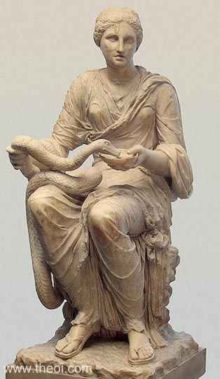 March 30 is the Festival of Salus, the Roman goddess of public safety, health and welfare.
March 30 is the Festival of Salus, the Roman goddess of public safety, health and welfare.
Salus was a minor goddess, the daughter of Aesculapius, the god of healing, whose staff, with a snake coiled round it, is symbolic of the practice of medicine. Their Greek equivalents were Aklepios and Hygeia. Her role in the pantheon was to feed and care for her father’s sacred snakes and act as his assistant. She was worshiped as being responsible for the welfare, not just of individuals, but of the people as a whole. Her name in Greek and Roman comes down to us in such words as ‘hygiene,’ ‘salve’ and ‘salubrious,’ and even ‘salute’ and ‘safe.’
In works of art, of which a considerable number has come down to our time, she was represented as a virgin dressed in a long robe, with the expression of mildness and kindness, and either alone or grouped with her father and sisters, and either sitting or standing, and leaning on her father. Her ordinary attribute is a serpent, which she is feeding from a cup.
To invoke the healing power of Salus (Hygeia) either of these two invocations can be used, or you can create an invocation of your own.
“O much desired, prolific, general queen. Hear me, life-bearing Hygeia, of beauteous mien, mother of all; by thee diseases dire, of bliss destructive, from our life retire; and every house is flourishing and fair, if with rejoicing aspect thou art there. Each daidal art thy vigorous force inspires, and all the world thy helping hand desires. Hades, life’s bane, alone resists thy will, and ever hates thy all-preserving skill. O fertile queen, from thee for ever flows to mortal life from agony repose; and men without thy all-sustaining ease find nothing useful, nothing formed to please. Without thy aid, not Hades’ self can thrive, nor man to much afflicted age arrive; for thou alone, of countenance serene, dost govern all things, universal queen. Assist thy mystics with propitious mind, and far avert disease of every kind.”
~ Orphic Hymn 68
“Hygeia, most revered of the blessed ones among mortals, may I dwell with you for what is left of my life, and may you graciously keep company with me: for any joy in wealth or in children or in a king’s godlike rule over men or in the desires which we hunt with the hidden nets of Aphrodite, any other delight or respite from toils that has been revealed by the gods to men, with you, blessed Hygeia, it flourishes and shines in the converse of the Kharites; and without you no man is happy.”
~from the Ariphron
Hidrellez (celebrated on May 6th) is a very significant day, not only for gypsies. It’s been very significant in Anatolia for centuries. The word itself is the combination of names of two prophets: Hizir and Ilyas. Hidrellez signifies a rebirth of nature and is also considered to be the beginning of summer. It is said that whatever you wish for that night comes true!
According to Anatolian people’s beliefs, Hizir and Ilyas are two prophets who drank from the fountain of youth; they are brothers and friends. They have given each other promise to meet on this night of May 5 every year to give rebirth to nature. Hizir is the protector of plants; he gives life to plants. He helps poor people. Wherever he goes, he brings abundance. Ilyas is the protector of waters and according to some, the protector of animals. Wherever he goes, animals become healthier.
People believe that wishes made on this night will come true. They also believe that sick people will become healthier and it will be the end of bad luck and misfortunes. There are also a lot of rituals that people perform.
Some people put a coin inside a red cloth and then hang it on a rose branch. In the morning this money is put into the wallet so that it will bring abundance. It is also believed that if you go out, have a picnic and be in nature on this day, your days in winter will have less hardship. Most city people know this day simply as a picnic day.
Although it is commonly celebrated everywhere in Turkey, its mood is more festive among the Roma community. Apart from Edirne, Istanbul also hosts a major celebration by the Romanis in the historic Ahırkapı district, which was marked with a parade of community members in extravagant and colorful costumes.
Source: Hurriyet Daily News
